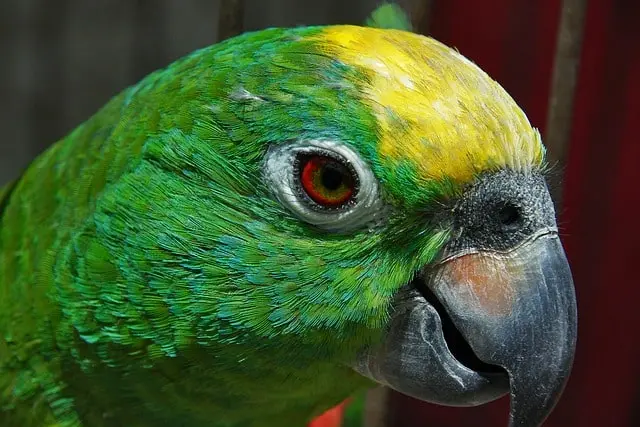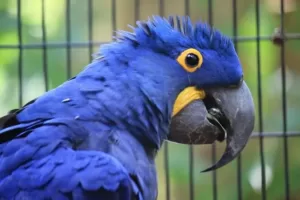Parrots usually sell for hundreds and thousands of dollars. The larger, rare, and more thrilling-looking a species you go for, the more expensive it is. And even some of the smaller ones are not easy on the pocket. But why are parrots so expensive?
Parrots command a high price due to several factors. Parrots, especially the larger ones naturally have low reproductive rates, which keeps their supply low. In order to successfully breed parrots, breeders spend a considerable amount of time and money, which also adds up to their costs.
Also, the restrictions posed by the government on the trade of endangered parrot species increase the cost of owning an exotic bird.
Quick Navigation
Reasons Why Are Parrots Expensive To Purchase
Low Reproductive Rate
Parrots are K-selected species, which are characterized by slow maturation, low reproductive rates, and long lifespans. Unlike most other animals and even some avian species, parrots breed only once every year.
This slow reproductive cycle poses a challenge for breeders as it limits the frequency with which they can produce offspring for sale.
Parrots are also slow to mature. Lager parrot species can take between 3-6 years to reach breeding age. Small to medium-sized parrots may take 1-3 years to reach sexual maturity.
These factors result in a limited supply of parrots in the market, as breeders cannot produce them at the same pace as species with higher reproductive rates.
Low breeding rates and slow maturation contribute significantly to the scarcity of certain parrot species, resulting in a higher price tag in the pet trade.
Breeding Cost
Breeding parrots is expensive. It involves providing suitable nesting environments, nutrition, healthcare, and unforeseen vet bills for both parent birds and their chicks. All these things cost breeders extra money, which influences the price of the bird.
Breeders also have to put time and effort into monitoring the breeding process, care for the eggs, and hand-raise the chicks, which also add to the overall breeding expenses.
Sadly though, many breeders engage in unethical practices to cut costs and increase their margins. They treat parrots as commodities breeding them too frequently without allowing adequate time for recovery.
They keep parrots in small enclosures and feed them an improper diet, leading to unhealthy and stressed birds.
These breeders may sell parrots at a cheaper price but as an informed and responsible pet owner, you should always inspect the breeder’s reputation and check the living conditions of the bird you are buying.
Reputable breeders care for the well-being and health of the parrots and invest in quality breeding practices that usually cost more.
Supply And Demand
People covet parrots because of their attractiveness, vibrant colors, and unique abilities, which drive their high demand.
However, there is often limited availability either due to geographical constraints, the parrot’s conservation status, or as mentioned earlier – low breeding rates. This contributes to the scarcity, especially for certain species, increasing their price in the market.
Also, if it is a rare species, there are numerous challenges in acquiring it from legal restrictions, geographical constraints, and extremely scarce supply, all of which drive its price incredibly high.
Rarity
Most of the highly sought-after parrot species are either endangered or headed in that direction. Due to their high demand, these parrots are over captured removing individuals of the species from their natural habitats and disrupting their population.
Illegal extraction and habitat destruction are two of the major problems parrots face. According to the American Museum of Natural History, most long-lived parrots have low reproductive rates, low chick survival, and limited nesting sites, which makes them highly sensitive to overexploitation.
Parrots are not prolific breeders and therefore their population is more vulnerable if overcaptured. But as a parrot species is not easily available in the market, it naturally becomes more expensive to obtain.

Legal Regulations
Many parrot species are not legal to own without a special permit from the state. Owning an endangered parrot species requires you to get a license, which is an added cost.
Limited Geographic Range
Parrots come from different places around the world, and each species is adapted to its specific natural habitat. This makes the availability of parrots contingent on the buyer’s location to some extent.
Importing parrots from their native habitats incurs additional expenses, including transportation and regulatory compliance costs, making them more expensive. But if you buy closer to the parrot’s place of origin, it is relatively cheaper due to reduced import-related expenditures.
FAQs
Are All Parrots Expensive?
The price of a parrot is determined by many factors and while there are some parrot species that are generally more expensive due to their rarity or desirability as pets, not all parrots are expensive.
Most common parrots species like the Budgies and Cockatiels, are usually more affordable compared to larger species like Macaws and cockatoos. One of the reasons for this might be that budgies and certain other species have a relatively early maturation age and can be bred more than once a year.
Are Talking Parrots More Expensive?
Parrots are not necessarily expensive because of their talking abilities. While that is certainly one of the factors, there are many affordable parrot species that have exceptional talking abilities. For example, the Indian ringneck parakeet is one of the more economical birds to purchase, but it is also one of the most adept talkers among parrots.







